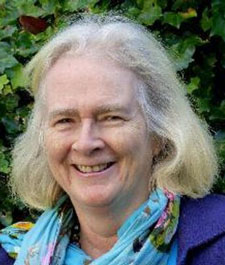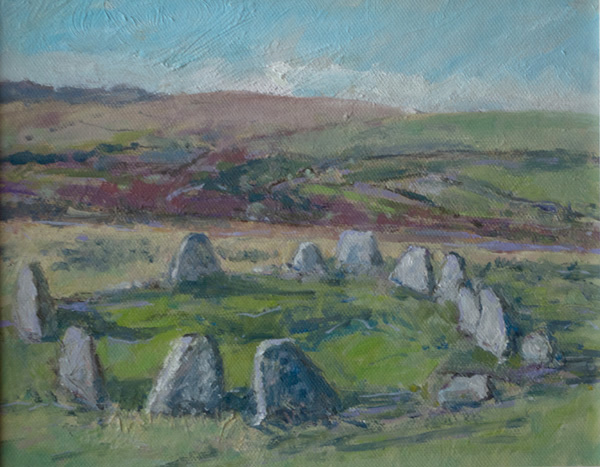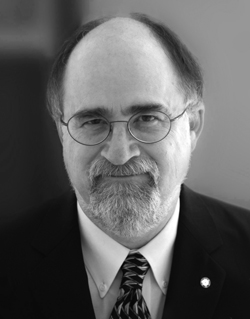A Stranger No More: A Journey through Mormonism
Printed in the Fall 2018 issue of Quest magazine.
Citation: Goldsberry, Clare, "A Stranger No More: A Journey through Mormonism" Quest 106:4, pg 14-17
By Clare Goldsberry
 When I announced to the pastor of my Disciples of Christ (Christian) Church that I was marrying a Mormon man, he looked only mildly surprised. “Well, I guess you’ll be joining the Mormon Church.”
When I announced to the pastor of my Disciples of Christ (Christian) Church that I was marrying a Mormon man, he looked only mildly surprised. “Well, I guess you’ll be joining the Mormon Church.”
“Oh, no,” I protested. “I’m happy in the Disciples Church.”
“You have too many questions,” he said,“and the Mormons have all the answers.”
What my pastor meant was that Mormons have truth claims that answer all the big questions of life: Who am I? Why am I here? Where am I going? They claim to have the truth of the Gospel of Jesus Christ and of the restoration of the True Church established by Jesus, an idea that was popular during the Second Great Awakening (ca. 1796̶-835), when the Church of Jesus Christ of Latter-day Saints—the Mormon church—was established.
At age twenty-one, I was at a point in my life when the words truth and true church sounded appealing. After all, aren’t we all searching for the truth? Marrying a Mormon seemed to be a door to that path. I did join the Mormon church, as my pastor had predicted, and embraced its doctrines and dogmas for almost ten years, even though many seemed strange to someone who’d been reared as a mainstream Christian. But it was made easier by moving to a small town north of Salt Lake City, Utah, where my then-husband had been reared.
This was the beginning of a spiritual path that would lead me to a greater understanding of religion as doctrines, dogmas, and organizations. My membership in the Mormon church would teach me the difference between legalism and love and would give me a better theology education than I could have ever gained in divinity school (my aspiration prior to marrying).
I tried being a good Mormon, and for a few years I succeeded. I soon realized my goal of being “sealed for time and all eternity” to my husband and our children in one of the church’s magnificent temples. But to obtain the all-important “Temple Recommend” required obeying the Word of Wisdom given by Mormonism’s founder Joseph Smith: being a good Mormon generally and participating in the life of the church; abstaining from tea, coffee, tobacco, and alcohol; and paying a “full” tithing—10 percent of one’s gross income.This was tracked each year during “Tithing Settlement”: each December you met with the bishop and wereasked to declare that you had paid a full tithing. You were given the opportunity to write a check at that time if you had not.
I took part in the temple ceremony in a large, elaborately decorated room filled with a hundred others. Some were there to receive their own “endowments” (as these initiations are called), while others received endowments in proxy for people who had died and whose relatives had submitted their names for this purpose. The women, dressed in long white dresses, sat on one side, and the men, dressed in white suits, sat on the other.
The movie shown to us (it used to be a play performed by live actors) contained the story of the formation of the True Church of Jesus Christ. It portrayed Adam and Eve in the Garden of Eden as well as their expulsion. I found some parts of the movie offensive, such as the portrayal of the disciples of Jesus and modern-day pastors as agents of Satan. (I’ve since heard that some of portions of the movie have been removed; probably I was not the only one who was offended.) At various stages, the movie was stopped, and we all took three sacred vows, each one having a horrible, bloody consequence if we were to ever violate it or reveal what we were learning in the temple. (I’ve heard that these have been changed as well, but I cannot confirm that.)
Being a good Mormon was easy, because the rules of life were laid out for me. All I had to do was follow them—unquestioningly. Many people like rules and the certainty that comes with rigid, legalistic religions, and for several years I enjoyed the box that kept me safe from the uncertainties of life. Most of my friends were comfortable with the legalistic doctrines of Mormonism, but then most had been born into the church. As a convert I was considered special—perhaps because my acceptance of their religion validated their own beliefs that theirs was the true church. But soon I began to chafe at the confinement, not because I needed more freedom to do as I pleased, but because I began to see the harm that a legalistic religion could do.
While the rules are designed to help ensure that individuals adhere to Mormon doctrines, I soon discovered that they also were used as a yardstick by which to measure the compliance of their neighbors and judge their actions. An elderly neighbor of mine who drank a cup of coffee every morning lived in fear that she would be found out by the bishopric of the ward. (A ward is the Mormon name for an individual congregation.) Each morning, no matter what the temperature, she would make her cup of coffee, then open all the windows to air out her house so that no one could smell the coffee, especially the bishop if he happened to drop by. In Mormonism, waking up and smelling the coffee is not something you want to do!
Members who were not following the strict rules of the church often found themselves on the outside. If not fully excommunicated, they were disfellowshipped, or placed on the outside, until they could once again follow all of the church’s rules. I happened to run into a member of my ward in the grocery store one day. She noticed that I had seen the six-pack of beer in her cart, and quickly apologized to me for the fact that her husband—a church member—did not keep the Word of Wisdom.
“He’s really trying to get back into the church,” she assured me, as if I was the one that was judging her husband. I had no interest in judging anyone and was often reminded of the New Testament scripture “Judge not, lest ye be judged.” Yet in a community in which around 95 percent of the people were Mormons, it was difficult to avoid being judged by someone. It was like living in a glass house, and there were plenty of people to throw stones.
Those who were not perfect “saints” in the Mormon tradition were not treated very well, which caused me to review my Christian upbringing. Mormons do not refer to themselves as Christians (something I was taught very early in my church membership), nor did many of those in the community know their Bible very well. Most of the emphasis was placed on the Book of Mormon. Odd, given that they call themselves “The Church of Jesus Christ of Latter-day Saints.”
Being under the microscope of the ward bishopric meant that members were accountable to the bishop or one of his two counselors for everything. One was expected to consult with the bishop in matters that in secular life would be considered private and personal choices, such as how many children to have. We women of childbearing age were expected to have children. It was a duty to bring spirits from heaven to obtain bodies, and it was taken very seriously. At one point, after my husband and I decided not to have any more children (I had four), I was called into the bishop’s office to explain why, since it had been several years since my youngest child was born. He certainly didn’t like the answer I gave him and warned me of my obligation to bring spirit children from heaven as “Heavenly Father” had taught us to do.
Much of this belief originates in the well-known statement made by Lorenzo Snow, the fifth president of the Mormon Church: “As man is now, God once was; as God is now, man may be.” Mormons believe that human males may become gods and rule over their own worlds, having numerous wives with whom to have “spirit” children to populate these other worlds with human beings. Whether or not Snow’s statement is church doctrine has long been disputed, but it is taught often enough.
After about eight years, I began stepping back from the church. I am a strong-willed person with my own mind-set, and my husband didn’t object, even though the bishop told him that he needed to rein me in. After all, in Mormon doctrine “husbands are the saviors of their wives.” I knew the consequences for us as a family of trying to remove myself from Mormonism. My children would be ostracized (and they were), and my friends in the ward would be told not to associate with me, as I was a danger to their faith.
The final straw was when the bishop called me in for another face-to-face meeting and asked me when I was going to quit my job and be a good mother. He also asked me when was I was going to quit writing articles for The Salt Lake Tribune about women’s issues. I was finished.
My husband got a job in Phoenix, Arizona, and we moved out of the fishbowl. It was there that I met my Waterloo with the church. I’d learned of a young woman with several children whose husband had divorced her, leaving her in a bad way financially. She’d met a wonderful man—not a Mormon—who’d begun providing for her and her children, and she’d been sleeping with him.
The bishop and his counselors had found out about this, because the young woman had been feeling guilty about the liaison and confessed this to her “home teachers”—men of goodstanding in the church who are given several families to call on each month to ensure that things are well. They informed the bishop, and she had been called to attend a council to disfellowship her. I went to visit her to comfort her, and I told her that God loved her no matter what. “The church might throw you out, but with God, you’re never out,” I said.
That too, got back to the bishop, because again she felt guilty about my visit with her. A few days later he knocked at my door and served me with papers to excommunicate me for “preaching false doctrine.” It was an official citation that called me to a hearing with seven members of the bishop’s council. I accepted the papers, telling him that as long as the citation meant no points off my driver’s license, I was OK with it. I laughed, thinking it was rather funny, but the bishop didn’t see the humor in it.
A few weeks later, I was brought up before these seven men in a church court, and my fate within Mormonism was to be decided. It was obvious what that fate was, but I was beyond caring. I challenged them with my “Sixteen Theses,” outlining why I felt that Mormonism was not a Christian religion. It was based on my many years of study and knowledge of the Scriptures. I wasn’t going to let these men have the last word where my spirituality was concerned. First, I said, it is the purpose of religion to serve the people, and to provide a vehicle by which people serve their God. When people begin serving the religion for the sake of the “church,” then Christianity has been lost. Also, when religion becomes a whip to be used to ensure obedience to the law, it is useless. Christ came to fulfill the law of the Old Testament, and usher in the new law—that of love. When rules are more important than love, Christianity has been lost.
I think some of them found it all rather amusing—as did I. My excommunication taught me that there are some dangers in being a spiritual seeker—including the belief that those in authority somehow have a truth to which I don’t have access. That isn’t the case. All the truth resides within our own hearts and souls, waiting to be discovered, waiting for the veil to be lifted from our eyes and the illusions revealed.
Even so, there is something reassuring in being dedicated to a strict dogma or to absolute doctrine. I’ve often thought that people like the Mormons, who believe without doubt that theirs is the only true church, may be more content with their absolutes that we who are spiritual seekers. But there is a big price to pay for that comfort, and that price is giving up one’s free will, relinquishing the freedom to seek, knock, and find one’s personal truth behind the door of one’s own heart.
In a speech given in the 1980s, Spencer W. Kimball, the Prophet, Seer, Revelator, and President of the Church of Jesus Christ of Latter-day Saints from 1973 to 1985,stated something that should strikefear into the heart of every spiritual seeker: “When the Prophet speaks, the thinking has been done.”
All my life I’d done nothing but ask questions—of my Sunday-school teachers, preachers, and anyone who would sit and discuss theology with me. Questions were my life’s sustenance, and I knew that the questions were always more important than the answers. I learned that once one had the answers the path ended, most of the time prematurely. There is always more, because the truth is never found in just one place outside of oneself. There are always more teachers to hear, more books to read, and more questions to ask, and that’s not a bad thing. But ultimately the truth can only be found within.
In his book AWestern Approach to Zen,Christmas Humphreys says that the meditator (and here I’d like to substitute the words spiritual seeker) “must find his own way, and as soon as possible realize that the only true teacher is within.”
As I wrote for Quest in June 2005,
To accept the exclusive truth of a particular religious organization as the ultimate truth is to cut ourselves off from seeking our personal truth; it is blind faith—faith that refuses to look beyond the boundaries set up by the religious organization; faith that rejects personal inquiry and follows blindly dictated truth, which isn’t truth after all. . . Seeking personal truth often involves learning to question all we have been told, and not being afraid of the answers we might find.
Finding one’s personal truth always has to do with a calling that is uniquely our own that comes from the inside out, not from a bishop, a rabbi, a guru, or any other person. It comes from within ourselves when we are called to travel a path in which we can best learn who we are and the purpose of our lives on this earth.
The motto of the Theosophical Society, “There is no religion higher than truth,” gave me the strength to continue my personal quest as a spiritual seeker and never to be content with anything less than the truth from the Source within. Supported by J. Krishnamurti’s statement “Truth is a pathless land,” I can gladly walk on, quoting a bumper sticker I once saw: “Just because I wander doesn’t mean I’m lost.” I’ve truly become a stranger no more.
Clare Goldsberry is a professional freelance writer and volunteer with RISE, a continuing education program for older adults on Eastern philosophies, the Ageless Wisdom, Gnosticism, and the Kabbalah. This article is adapted from A Stranger in Zion, her memoir of her years as a Mormon housewife. She is a member of the TS’s Phoenix Study Group.



 In Hinduism, there are many pairs of male and female gods, devatas and devis, which express unique attributes or energies that interplay throughout the universe. The best-known are those of the Trimurti, the holy trinity of Hinduism: Brahma and his consort Saraswati, Vishnu and Lakshmi, and Shiva and Parvati. These pairs of devatas and devis represent a dual energy, called purusha and prakriti.
In Hinduism, there are many pairs of male and female gods, devatas and devis, which express unique attributes or energies that interplay throughout the universe. The best-known are those of the Trimurti, the holy trinity of Hinduism: Brahma and his consort Saraswati, Vishnu and Lakshmi, and Shiva and Parvati. These pairs of devatas and devis represent a dual energy, called purusha and prakriti.  On a cold spring day in March 1981, a small band of women gathered at the Nine Ladies stone circle in the Peak District of Derbyshire in the north of England. They had come seeking inspiration for a new vision of women’s spirituality and a common way to work together, and they had been drawn to this spot by the name of this circle.
On a cold spring day in March 1981, a small band of women gathered at the Nine Ladies stone circle in the Peak District of Derbyshire in the north of England. They had come seeking inspiration for a new vision of women’s spirituality and a common way to work together, and they had been drawn to this spot by the name of this circle.
 The last several years have seen an upsurge of attention to gender issues. Whether it has been the controversies over transgender bathroom policy, the heavily publicized transitioning of Bruce Jenner into Caitlyn Jenner, or Facebook continually upping the number of gender identities that its members can choose from—they stood at seventy-one at last count—gender has commanded our attention at every turn.
The last several years have seen an upsurge of attention to gender issues. Whether it has been the controversies over transgender bathroom policy, the heavily publicized transitioning of Bruce Jenner into Caitlyn Jenner, or Facebook continually upping the number of gender identities that its members can choose from—they stood at seventy-one at last count—gender has commanded our attention at every turn.